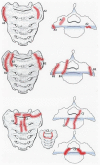Sacroplasty for Sacral Insufficiency Fractures: Narrative Literature Review on Patient Selection, Technical Approaches, and Outcomes
- PMID: 38398413
- PMCID: PMC10889545
- DOI: 10.3390/jcm13041101
Sacroplasty for Sacral Insufficiency Fractures: Narrative Literature Review on Patient Selection, Technical Approaches, and Outcomes
Abstract
Sacral insufficiency fractures commonly affect elderly women with osteoporosis and can cause debilitating lower back pain. First line management is often with conservative measures such as early mobilization, multimodal pain management, and osteoporosis management. If non-operative management fails, sacroplasty is a minimally invasive intervention that may be pursued. Candidates for sacroplasty are patients with persistent pain, inability to tolerate immobilization, or patients with low bone mineral density. Before undergoing sacroplasty, patients' bone health should be optimized with pharmacotherapy. Anabolic agents prior to or in conjunction with sacroplasty have been shown to improve patient outcomes. Sacroplasty can be safely performed through a number of techniques: short-axis, long-axis, coaxial, transiliac, interpedicular, and balloon-assisted. The procedure has been demonstrated to rapidly and durably reduce pain and improve mobility, with little risk of complications. This article aims to provide a narrative literature review of sacroplasty including, patient selection and optimization, the various technical approaches, and short and long-term outcomes.
Keywords: balloon-assisted; coaxial; interpedicular; long-axis; sacral insufficiency fractures; sacroplasty techniques; short-axis; transiliac.
Conflict of interest statement
B.G.D. discloses consulting fees from Spineart, Clariance, and Spinevision. J.K.C. discloses consulting fees from Stryker, Globus, Lifespan, CTL Amedica, Spineart, and Neuromonitoring Associates. A.H.D. discloses the following, receives royalties from Spineart and Stryker, consulting fees from Medtronic, research support from Alphatec, Medtronic, and Orthofix, and fellowship support from Medtronic. The other authors have nothing to disclose.
Figures





References
-
- Urits I., Orhurhu V., Callan J., Maganty N.V., Pousti S., Simopoulos T., Yazdi C., Kaye R.J., Eng L.K., Kaye A.D., et al. Sacral Insufficiency Fractures: A Review of Risk Factors, Clinical Presentation, and Management. Curr. Pain Headache Rep. 2020;24:10. doi: 10.1007/s11916-020-0848-z. - DOI - PubMed
Publication types
LinkOut - more resources
Full Text Sources

